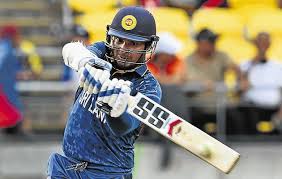
Kumar Sangakkara talks about one-day batting: technique, mindset, risk calculation, touch v power, and innovation…….
How have demands on one-day batsmen changed since you began?
Roles of batsmen have changed. When I started, for a long time they told me my job was to bat 40 overs and let everyone else bat around me. It was a case of just holding the fort and playing, playing, playing. That was basically my job at No. 3. But when the sides changed, when your role changed from being a guy who bats 40 overs to someone who could score quickly and bat for only 20 overs, and that’s still good enough for the side. Everyone is thinking about making an impact with their run-making.
Now when I go in to bat, if the situation calls for it, I’ve tried to keep my strike rate at around 100. I know that if I’m anywhere between 85 to 100 when the Powerplay comes, I know I can kick that up to 120-130 or even further. The mindsets have all changed. You don’t hold the fort for the rest of the guys anymore. The rest of the guys are capable of doing that.
How is your technique and mindset different now, compared to the start of your career?
With technique, I bat differently each game, probably. Sometimes I don’t tap the bat. Other times I change my set-up. What I realised is that in one-day cricket you can do all of that and sometimes need to do all of that to get yourself momentum, create pressure or get a better rhythm, depending on the stage of the innings. For example, I’d tap the bat and I’d keep it up if there’s a bit of pace around, and look for other areas to score singles.
More importantly, if there’s a weak link in a bowling attack, you’ve got to take advantage of it. If they are bowling a part-timer and you’ve had a good start, you take them on because that creates a lot of pressure. That attitude has been there for a long time from other sides, but for us it’s been a case where now, consciously, we’ve made the change to go after them.
Spinners also now have the extra fielder up because of the new rules. So you try and create pressure on the spinner by taking the boundaries on. It’s just a case of trying to reverse pressure. More often than not, it works.
Were there players you tried to emulate at different stages of your career?
There were lots of people, but the point is, I have to work it out my way. I admired the way Mahela Jayawardene manipulates spin, or the way Tillakaratne Dilshan hits the short ball, but I had to figure out what works for me. There were various things I wanted to do, but I have a certain way that I bat and I expand on that foundation.
How important is calculation of risk, from ball to ball, in constructing an ODI innings?
It’s important because, for example, in our quarter-final, when I went in to bat, Kyle Abbott was bowling a solid line and length, and there were times when I was thinking maybe I could skip down the track and hit over the infield. But with two wickets down for nothing, it probably was better to hold the fort, especially when we were playing only six batsmen in the side.
If a bowler has bowled three dot balls, if he’s set a particular field and you’re reading it, I think it’s very advantageous to put a thought in his head to say you’re aware of what he’s trying to do and that you’re going to take him on. The moment that happens, it frees you up in other areas – where the bowler will suddenly try and avoid doing a certain skill he is good at to try and curb that one shot that you hit.
If you take a lot of batsmen, even if they do take a calculated risk, they play the averages quite well. It could be over a short boundary or a part of the field that’s in, or just one bowler. Especially when there’s been a string of good overs. It’s worked well for my game.
How did you hone your ability to calculate risk? It’s seemed to be a real strength for you.
Sometimes if you overthink, it doesn’t work. Often you’ll just get a little thought in your head that you should hit out, and it’s good then to take the option on. That’s been the key, rather than planning things. You just go to bat, get a feel of things, and automatically the thought hits you: “This is the bowler to do it against.” You act on that.
You’ve added many shots to your game in the past few years. Could you talk through the process of expanding your repertoire?
I would work the shot out in my head first before going to the nets. I’d get throwdowns on it, and I would add it to my repertoire in situations where I feel comfortable, and we’ve got enough runs on the board, so it’s not a huge risk if I get out doing it. I especially try to execute those during a Powerplay: a paddle maybe, a slog off a fast bowler, inside out or a dink to third man. Once I’m comfortable working with it in my innings, I add it more frequently, and then it goes along like that until it becomes a natural part of my game.
It’s been great watching other players go through the same thing. Dilshan’s been one of the most impressive ODI batsmen in the last four to five years. He’s just scored such a lot of runs so consistently and quickly. His innovations with the paddles, and the willingness to take the fast bowlers on, is a good example of how expanding your game can really give you an edge. Guys like AB de Villiers are doing that too.
But then if you look at Virat Kohli, it’s really interesting. He doesn’t play a lot of dinky shots, but he’s really effective. Most of the time he’s playing orthodox cricket shots. Sometimes you can be carried away and try to be too innovative. I’ve watched a lot of players and how they’ve developed their game, and I’ve tried to do the same.
You’ve spoken about batting best when you’re not thinking. What does a batting plan look like for you now? How has that changed over the years?
Most of the time I’m avoiding thinking about what will come next, or “What if I get out?” It can be tough to get things out of your head. You also have to trust the other batters around you, who are more than competent to do a job. The only thing is, you’ve got to create a situation that is comfortable for them to come and express themselves. That’s what I tried to do. By the time I get out, the ideal thing is for the batsman
For example, in Hamilton in the recent ODI against New Zealand there, I went in and tried to get my rhythm, but it wasn’t working. My next option was to try and take Nathan McCullum on, even if there was a chance of me getting out, I wanted to hit him out of the ground a couple of times. I tried to take Trent Boult on by walking up and down the pitch and really taking a lot of risk. Dilshan was batting beautifully at the other end, and I only got about 38, but it was almost at a run a ball, chasing 250. Because I wasn’t batting as well as I liked, the objective became to score as many as quickly as I could, so the guy coming in would have some time to settle. Marvan Atapattu came and told me: “That wasn’t your typical innings”, and I said, “If I had played my typical innings, I might have taken too much time.” It was better for me to just go for it.
You and Mahela have been touch players and you made the ODI game work for you. Do players like you have as good a chance to be successful in ODIs with the way the game is going?
I think now you need to have a combination of touch and power. Angelo Mathews is a good example of touch and power – he has a beautiful balance of both. But look at our side: we’ve made three World T20 finals and won one. That’s not by power-hitting. We’ve beaten the power-hitting sides quite easily and convincingly in all of those tournaments. There are other ways you can be effective; you don’t have to hit towering sixes all the time. For players like myself, like Mahela, or any one of the Sri Lankan batsmen, there’s no barrier to becoming good in the shorter formats.
You’ve played a lot in Sri Lanka, where scores are much lower on average than we’ve seen at this World Cup. Has the balance shifted too far toward batsmen elsewhere?
That’s why they’ve introduced the two new balls, but I don’t think that’s really worked. On wickets that don’t swing and seam, the new balls just stay harder for batsmen to hit farther. The spinners very rarely get turn anymore, unless you’re a wristspinner. You rarely see reverse swing. A lot has gone out of the game. With one new ball, there used to be everything in a game. You used to have swing at the start, then the ball softer, making it more difficult for batsmen to score. You had spinners really turning the ball, and you had quicks coming back reversing. I think one new ball would work better. Now the big fast bowlers – not the subcontinental fast bowlers – have an advantage. But even with them, if they don’t get two or three wickets in the first ten overs, it can be a struggle. Batsmen now hold the fort for the first ten.
Also in the death overs, because there is no reverse, it’s hard to hit your yorkers unless you’re Lasith Malinga or Mitchell Starc. Even after the 35th over, in the Powerplay, bowlers can really struggle. Most sides back themselves to set 300, and then see if their fast bowlers can make an initial impact.
Do young batsmen arriving in international cricket now have to pick things up quicker than when you began?
Definitely. There’s a lot more pressure on younger batsmen these days than when we came in. There’s media pressure and social media now. They don’t just have batting to worry about – the criticism is much harsher these days. People are not as patient with young batsmen as they used to be. That’s a shame. I look at these young batsmen in our side and I compare myself to them at that age and these guys are streets ahead. They need a bit of love and understanding and care and they’ll be fantastic players. You have to give them room and the time to grow, and if you can afford them that, then you’ll really see the fruits.
Who are the rising ODI batsmen around the world who you think will make a big impact in the next few years?
If you take Sri Lanka, Lahiru Thirimanne has been so amazingly impressive over the years. He’s batting in every single position and doing his best. He and Dinesh Chandimal are going to be very, very good. Even Dimuth Karunaratne, who came in as an opener and batted in the middle, batted with a lot of freedom and rhythm.
If you take India, you’ve got to talk about Ajinkya Rahane. The rest of the batsmen you can’t call young any more. I love watching Rahane because he’s really classical but also so effective. He’s developed a lot. For New Zealand, Kane Williamson is an absolute star in every format of the game. For Australia, if you consider where Steven Smith was to where he is now, it’s unbelievable. Again, not the greatest of power-hitters, but he’s incorporated every aspect of the game into his play. It’s an exciting time to be a batsman.
Categories: Cricket,Top Stories



